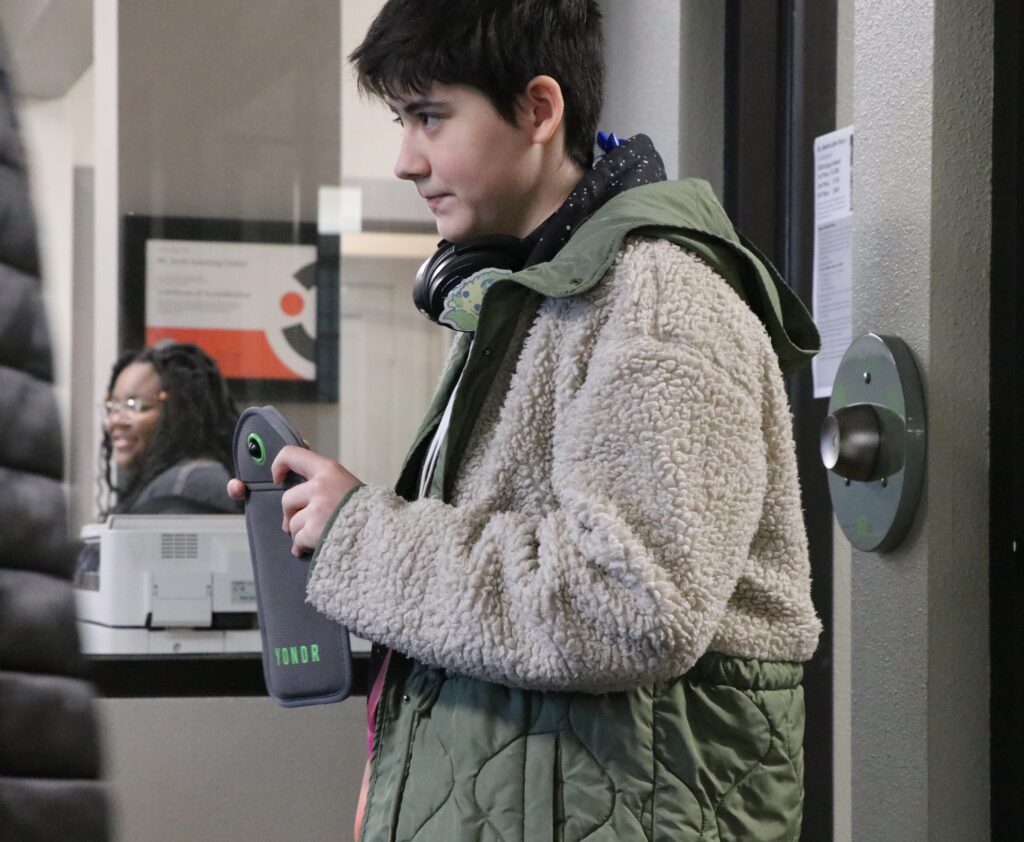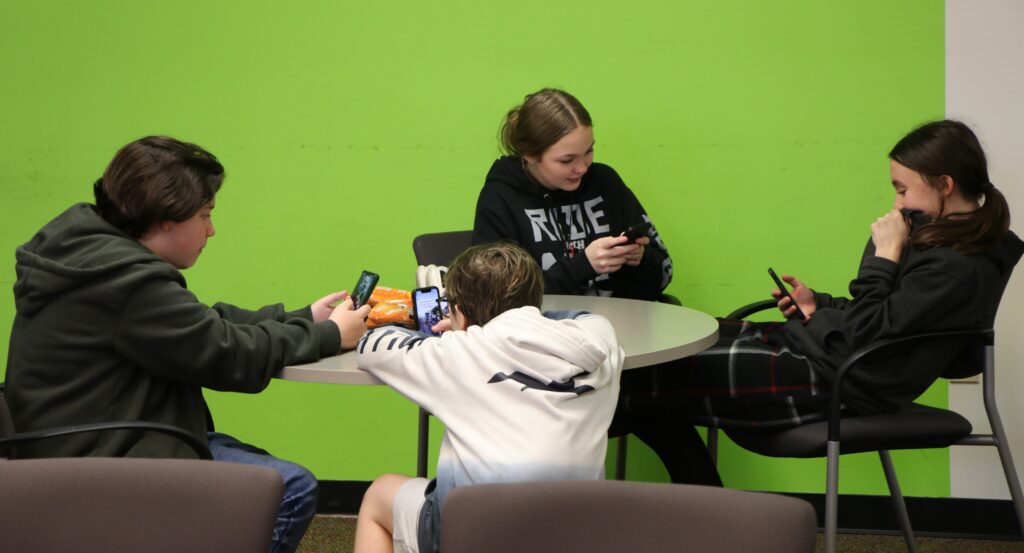
Nicholas Dillon, a senior at Mt. Scott Learning Center, prepares to put his phone in a Yondr pouch after using the device on the wall behind him to unlock it. Students can keep their phones with them but can’t access them during the school day. (Photo by Jake Arnold, OSBA)
Students waiting for the Mt. Scott Learning Center school day to start gathered in the cafeteria on a recent morning. They played table tennis and pool, chatted at tables or gathered around a student playing a piano in the corner.
Not a cellphone was in sight.
The Portland alternative high school has completely banned cellphones in the building, and many students say they prefer it.
Junior Jonah Duncan said he initially rebelled when told he would have to stay off his phone. But it has helped him focus on his classes and raise his failing grades to all A’s, he said. Now he is a fan of the school’s cellphone ban.
Educators around the world agree cellphones are a pox on students’ learning, mental health and social interactions. Removing the ubiquitous devices is easier said than done, though. Cellphone bans constantly run into enforcement problems, with uneven application by teachers and staff who already have enough to do.
Mt. Scott has found a technological solution that helps them. More than two years of implementation has shown administrators and teachers it’s well worth it for schools to find a way to remove phones from the school day, they say.
Social media threatens young people’s mental health, the U.S. surgeon general warned last year. Teachers say the media accessed on phones often take students’ focus off learning and lead to bullying, fights and tears.
Students around the world report cellphones distract them from classes, according to the Program for International Student Assessment 2022 results. The report concludes that cellphone bans appear useful but are difficult to enforce.
In the U.S., 77% of U.S. schools had some sort of cellphone ban in 2019-20, according to The National Center for Education Statistics. But nearly all U.S. students report using their cellphones during the school day, according to a 2023 report from Common Sense Media and the University of Michigan Medical School, showing the bans are often ineffective.
Tom DeJardin, executive director of the nonprofit school that serves Portland Public Schools students, said the Yondr pouch is their answer. Students can keep their phones with them, but they can’t access them. Teachers don’t have to do a thing.
Every student has their own pouch. Not much bigger than a cellphone, the pouch has a magnetic lock that is opened with a device mounted by the school entrance.
On a recent morning, several staff greeted students as they entered the school. Some students handed over their phones to be charged during the day or just to be stored. The rest pulled the Yondr pouch out of bags or coats and sealed up their phones before heading to class. At the end of the day, they will open their pouch with a swipe on the way out.
In between … no phone use.
“We believe learning happens best when it’s in relationship to the school community and to those around you,” DeJardin said. “Removing easy access to personal devices allows students to engage more deeply in the social and academic experiences of school.”
Mt. Scott staff say the ban has transformed the school’s culture, increasing attention during classes, reducing student conflict and generally improving relationships. Teacher Phil Johnson said he chose to work at Mt. Scott because of the ban.
“They are a community here because they look in each other’s eyeballs,” he said.
About 150 students pass through the doors each day. By now staff know the students’ tricks pretty well. Students have cut holes in the pouches, broken the locks and tried to pass off dead phones as their cellphones. They have claimed they don’t have a phone or left it at home.
“Are you pouching today?” Aaron Balogh, director of student life, asked a student who breezed past the doors. The young man stopped and dropped his phone in his pouch without complaint.
Another student was texting as he headed down the hall. Balogh didn’t say anything because he knows this particular student is a rigid rule follower and will put it away before he reaches the cafeteria.
“We have the luxury of knowing each student,” Balogh said.
The school’s small size also makes the pouching process more manageable and kept the contract to $11,500 for three years, including launch support, he said.
Administrators know students can still tap into digital life with tablets, laptops and watches, but the interactions are not as consuming as a phone. The school isn’t trying to blot out electronics but instead help students learn how to manage them.
Balogh said it generally hasn’t been a power struggle with students, especially after the first few weeks.
“Yondr is a tool,” Balogh said. “It’s not a failsafe. It’s almost a symbolic gesture.”
Reedsport Community Charter School, a junior/senior high school on the coast, typifies the more common approach in Oregon. Reedsport forbids cellphone use in classrooms but allows it during passing periods and lunches. Any student spotted with a cellphone in class must go to the office, with steadily mounting repercussions for repeat violations.
Principal Jerry Uhling said it is like any other policy, with some teachers enforcing it more stringently than others. Uhling said the school is trying to teach students how to use cellphones — and the attendant social media and internet access — responsibly.
During a recent lunch period, groups of Reedsport students were scattered about the library. Nearly every hand held a computer or phone. Some were laughing and sharing their screens while others sat side by side absorbed in their own worlds.

Reedsport Community Charter School students take advantage of the lunch period to spend time on their phones. They are not allowed to use their phones in the classrooms. (Photo by Jake Arnold, OSBA)
Uhling said he would love to be able to block all cellphone use in the building but that wouldn’t be preparing them for today’s world.
Nearly every Mt. Scott student questioned said they initially hated the policy, but now their feelings about it range from a shrug to enthusiastically in favor.
Sophomore Melina Lineberry-Wilson is the rare teenage student who doesn’t have a cellphone. She said this school year has been much better socially than last school year when she was at Portland’s Ida B. Wells High School. Portland Public allows schools to set their own policies. Ida B. Wells requires cellphones to be off during class time, but they can be used at other times.
Lineberry-Wilson said her fellow Mt. Scott students are much more willing to talk between classes and during lunch.
“It’s like you exist,” she said.
– Jake Arnold, OSBA
jarnold@osba.org